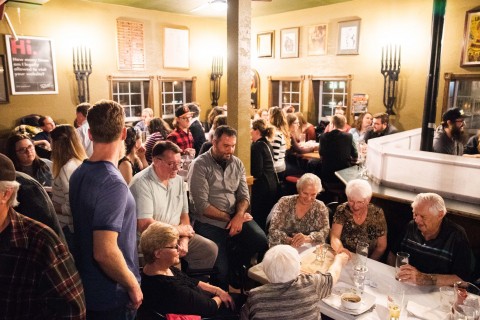The 7 Nights of Historical Villainy series had its second lecture on Oct. 17 at the Hose and Hydrant, focusing on the fictional laundry owner Mr. Burrows, who is part of the Tunnels of Moose Jaw tour.
The 7 Nights of Historical Villainy series is a monthly event hosted by the University of Saskatchewan’s department of history. The series began in September with a discussion on Eadric Streona, an Anglo-Saxon viking collaborator.

Attendants of the 7 Nights of Historical Villainy event, held at the Hose and Hydrant on Oct. 17.
Ashleigh Androsoff, an assistant professor in the department of history, led the latest lecture, which discussed the representation of Chinese Canadians in The Passage to Fortune tour through the Tunnels of Moose Jaw.
The Tunnels of Moose Jaw are one of Saskatchewan’s most popular tourist attractions, featuring two main tunnel tours: The Chicago Connection, in which the guests play the part of a bootlegger following one of Al Capone’s goons, and The Passage to Fortune, in which visitors are supposed to act as Chinese immigrants. In this role, according to the Tunnels of Moose Jaw website, “your passage to fortune is just around the corner.”
Androsoff became interested in this particular topic after she was contacted by a filmmaker in Toronto who asked her about the Moose Jaw tunnels. Based on the knowledge that she already had, at a first glance, The Passage to Fortune tunnel tour already did not make sense.
“Something wasn’t adding up,” Androsoff said. “Maybe I didn’t know as much as I thought I knew.”
After a bit of research, Androsoff says it became clear to her that this particular tour tells a story based on racialized stereotypes rather than actual facts.
In the tour, the characters that you meet are all fictional, but they are said to be based on real people and events. The tour is marketed as historical, claiming that sound research was used to create the stories behind the tunnels — but Androsoff says she noticed many historical inaccuracies.
Anderson claims that the historical reality of the situation was not so simple. The tunnel tour depicts the Chinese immigrants of the time as individuals without agency, working for cruel bosses who constantly berated them, when many of them were actually able to own successful businesses.
Absent from the narrative of the tours, Androsoff says, is the fact that many Chinese immigrants were often able to prevail despite the turn-of-the-century brand of racism that they would have faced. Androsoff believes that the narrative is woven this way in the tunnel tour because the racist undertones are easier for people to believe. You have to get over the racism in order to get to the truth.
As for why the tunnels still continue to perpetuate this narrative, it would seem that many of the people living in Moose Jaw continue to be proud of the tour, believing that it tells a true story that everyone should be aware of, Androsoff says.
Other citizens might only believe in its entertainment value, caring less about the facts and how it portrays this group of people. According to Androsoff, many people do not realize that the Chinese immi- grants who settled in Moose Jaw at this time have not been given adequate respect or consultation — their stories are not being told.
Androsoff believes that there could be a better way to portray the past in this particular context without losing out on the attractiveness of the tunnel tours.
“I hope that change will occur, but there is not a current willingness,”Androsoff said.
The next lecture in the 7 Nights series will take place at the Hose and Hydrant Brewing Company at 6 p.m. on Wednesday, Nov. 21. The lecture is titled Joseph Trutch and Richard Moody: Canada’s Pacific Coast Villains who Destroyed Indigenous Societies. The event is free and open to the public.
—
Nicole Wickenberg
Photo: Riley Deacon / Photo Editor